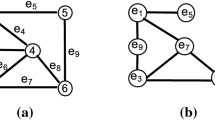Abstract
We study approaches for the exact solution of the NP-hard minimum spanning tree problem under conflict constraints. Given a graph \(G(V,E)\) and a set \(C \subset E \times E\) of conflicting edge pairs, the problem consists of finding a conflict-free minimum spanning tree, i.e. feasible solutions are allowed to include at most one of the edges from each pair in \(C\). The problem was introduced recently in the literature, with several results on its complexity and approximability. Some formulations and both exact and heuristic algorithms were also discussed, but computational results indicate considerably large duality gaps and a lack of optimality certificates for benchmark instances. In this paper, we build on the representation of conflict constraints using an auxiliary conflict graph \(\hat{G}(E,C)\), where stable sets correspond to conflict-free subsets of \(E\). We introduce a general preprocessing method and a branch and cut algorithm using an IP formulation with exponentially sized classes of valid inequalities for both the spanning tree and the stable set polytopes. Encouraging computational results indicate that the dual bounds of our approach are significantly stronger than those previously available, already in the initial LP relaxation, and we are able to provide new feasibility and optimality certificates.

Similar content being viewed by others
References
Achterberg, T.: Conflict analysis in mixed integer programming. Discret. Optim. 4(1), 4–20 (2007). doi:10.1016/j.disopt.2006.10.006
Atamtürk, A., Nemhauser, G.L., Savelsbergh, M.W.: Conflict graphs in solving integer programming problems. Eur. J. Oper. Res. 121(1), 40–55 (2000). doi:10.1016/S0377-2217(99)00015-6
Balas, E.: Disjunctive programming. In: 50 Years of Integer Programming 1958–2008, pp. 283–340. Springer, Berlin Heidelberg (2010)
Balas, E., Yu, C.: Finding a maximum clique in an arbitrary graph. SIAM J. Comput. 15(4), 1054–1068 (1986). doi:10.1137/0215075
Darmann, A., Pferschy, U., Schauer, J.: Determining a minimum spanning tree with disjunctive constraints. In: Rossi, F., Tsoukias, A. (eds) Algorithmic Decision Theory, Lecture Notes in Computer Science, vol. 5783. Springer, Berlin Heidelberg, pp. 414–423 (2009). doi:10.1007/978-3-642-04428-1_36.
Darmann, A., Pferschy, U., Schauer, J., Woeginger, G.J.: Paths, trees and matchings under disjunctive constraints. Discret. Appl. Math. 159(16), 1726–1735 (2011). doi:10.1016/j.dam.2010.12.016
Dezső, B., Jüttner, A., Kovács, P.: LEMON—an open source C++ graph template library. Electron. Notes Theor. Comput. Sci. 264(5), 23–45 (2011). doi:10.1016/j.entcs.2011.06.003
Edmonds, J.: Matroids and the greedy algorithm. Math. Program. 1, 127–136 (1971). doi:10.1007/BF01584082
Gerards, A., Schrijver, A.: Matrices with the Edmonds-Johnson property. Combinatorica 6(4), 365–379 (1986). doi:10.1007/BF02579262
Goldberg, A.V., Tarjan, R.E.: A new approach to the maximum-flow problem. J. ACM 35(4), 921–940 (1988). doi:10.1145/48014.61051
Grötschel, M., Lovász, L., Schrijver, A.: Geometric algorithms and combinatorial optimization. Springer, Berlin Heidelberg (1988)
Magnanti, T.L., Wolsey, L.A.: Chapter 9 Optimal trees. In: Ball, M.O., Magnanti, T.L., Monma, C.L., Nemhauser, G.L. (eds) Network Models, Handbooks in Operations Research and Management Science, vol. 7. Elsevier, Amsterdam, pp. 503–615 (1995)
Öncan, T., Zhang, R., Punnen, A.P.: The minimum cost perfect matching problem with conflict pair constraints. Comput. Oper. Res. 40(4), 920–930 (2013). doi:10.1016/j.cor.2012.10.022
Padberg, M.: On the facial structure of set packing polyhedra. Math. Program. 5(1), 199–215 (1973). doi:10.1007/BF01580121
Padberg, M.W.: Covering, packing and knapsack problems. In: Hammer, P.L., Johnson, E.L., Korte, B.H. (eds.) Annals of Discrete Mathematics, vol. 4. Elsevier, Amsterdam, pp 265–287 (1979)
Pferschy, U., Schauer, J.: The knapsack problem with conflict graphs. J. Graph Algortihms Appl. 13(2), 233–249 (2009). doi:10.7155/jgaa.00186
Pferschy, U., Schauer, J.: The maximum flow problem with disjunctive constraints. J. Comb. Optim. 26, 109–119 (2011). doi:10.1007/s10878-011-9438-7
Punnen, A.P., Zhang, R.: Quadratic bottleneck problems. Naval Res. Logist. (NRL) 58(2), 153–164 (2011). doi:10.1002/nav.20446
Rebennack, S., Reinelt, G., Pardalos, P.M.: A tutorial on branch and cut algorithms for the maximum stable set problem. Int. Trans. Oper. Res. 19(1–2), 161–199 (2012). doi:10.1111/j.1475-3995.2011.00805.x
Rossi, F., Smriglio, S.: A branch-and-cut algorithm for the maximum cardinality stable set problem. Oper. Res. Lett. 28(2), 63–74 (2001). doi:10.1016/S0167-6377(00)00060-2
Sadykov, R., Vanderbeck, F.: Bin packing with conflicts: a generic branch-and-price algorithm. INFORMS J. Comput. (2012). doi:10.1287/ijoc.1120.0499
Tomita, E., Tanaka, A., Takahashi, H.: The worst-case time complexity for generating all maximal cliques and computational experiments. Theor. Comput. Sci. 363(1), 28–42 (2006). doi:10.1016/j.tcs.2006.06.015
Zhang, R., Kabadi, S.N., Punnen, A.P.: The minimum spanning tree problem with conflict constraints and its variations. Discret. Optim. 8(2), 191–205 (2011). doi:10.1016/j.disopt.2010.08.001
Acknowledgments
The authors wish to thank the anonymous reviewers for carefully reading the manuscript and for the suggestions that helped improving our presentation. Phillippe Samer is supported by a grant from CAPES (Coordenadoria de Aperfeiçoamento de Pessoal de Nível Superior, Brazil). Sebastián Urrutia is partially supported by CNPq (Conselho Nacional de Desenvolvimento Científico e Tecnológico, Brazil) grant 303442/2010-7.
Author information
Authors and Affiliations
Corresponding author
Rights and permissions
About this article
Cite this article
Samer, P., Urrutia, S. A branch and cut algorithm for minimum spanning trees under conflict constraints. Optim Lett 9, 41–55 (2015). https://doi.org/10.1007/s11590-014-0750-x
Received:
Accepted:
Published:
Issue Date:
DOI: https://doi.org/10.1007/s11590-014-0750-x




